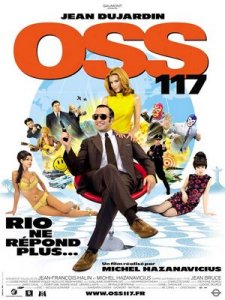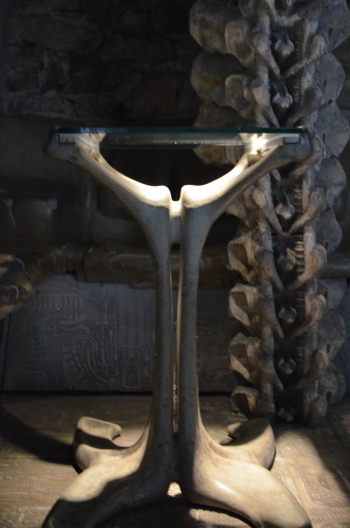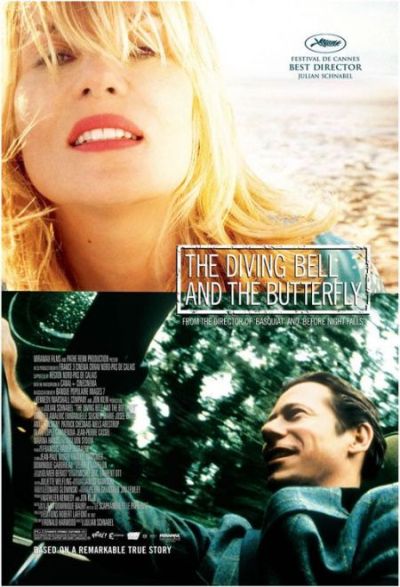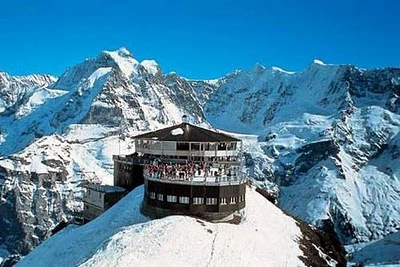I have been trying to watch TV in French. Unfortunately, there are not many great television series in French. Thankfully, friends have suggested French movies for me to watch (thanks guys).

Thanks to Igor Film and Casbah Film
Volumes have been written on French cinema and there are endless ways of classifying meritorious French films (best, top, famous classic, popular, recent, great, good, and must see). Classics like the 400 Blows, Belle du Jour, Un Chien Andalou, and The Battle of Algiers, do not appear on this list. These films were chosen not for their cinematic adroitness, but for their entertainment value and insight into French culture. They are divided into the following categories: Comedy, Black Comedy, Classics by Jaques Tati, Romantic Comedy, Dramatic Comedy, Dramas, Action, Animated/Cartoon, and TV (which contains a couple of old television series).

Thanks to Gaumont Films
Comedy
Les Bronzés (French Fried Vacation) – Released in 1978, directed by Patrice Leconte, and starring Michel Blanc, Marie-Anne Chazel, Gérard Jugnot, Thierry Lhermitte, Josiane Balasko and Christian Clavier. Perhaps I should have listed this under the “Cult” category as this satire was done my the famous sketch comedy group, Le Splendid. Six vacationers from France find themselves in a Club Med like setting and take part in the organized fun.
Les Bronzés Font Du Ski (French Fried Vacation 2) – Released in 1979, directed by Patrice Leconte, and starring Michel Blanc, Marie-Anne Chazel, Maurice Chevit, Gérard Jugnot, Thierry Lhermitte and Christian Clavier. The first film was such a success that they made a second one on the slopes. This film is still quoted by Francophones (French speakers) on the slopes. With all the skiing we have been doing lately, it is required viewing.

Courtesy of Trinacra Films
Le Père Noël Est Une Ordure (Santa Claus Is A Bastard)– Released in 1982, directed by Jean-Marie Poiré, and starring Thierry Lhermitte, Gérard Jugnot, Christian Clavier, Anémone and Josiane Balasko. In this burlesque comedy classic, the main character hands out leaflets advertising a sexy Christmas party, but his girlfriend leaves with Santa.
La Grande Vadrouille (Don’t Look Now… We’re Being Shot At!, literally translated as “The Great Stroll”) – Released in 1966, directed by Gérard Oury, and starring André Bourvil, Louis de Funès, Terry-Thomas, and Claudio Brook. For over forty years, this film was the most successful film in France. The crew of a RAF bomber shot down over Paris must then make their way through German-occupied France with the help of two French citizens.

Courtesy of Pathé Renn Productions
Bienvenue Chez Les Ch’tis (Welcome to the Sticks, Welcome to the Land of Shtis) – Released in 2008, directed by Dany Boon, and starring Kad Merad, Dany Boon and Zoé Félix. This is the most successful French film ever. A man born and raised on France’s Southern coast is exiled to the Northern territories as punishment for lying to the government. He is forced to relocate to the north of France, between Belgium and the English Channel where they speak an amalgam of French, Flemish and Latin. He encounters cultural differences and struggles to adapt to his new life.
OSS 117: Le Caire Nid D’Espions (OSS 117: Cairo, Nest Of Spies) – Released in 1996, directed by Michel Hazanavicius, and starring Jean Dujardin (the French George Clooney who has recently achieved recognition for is work in The Artist), Bérénice Bejo, and Aure Atika. This spy comedy parodies Bond films and uses lame sight gags, crass sexual innuendo, juvenile action sequences, and hilarious coded conversations to great effect. He even watched some of it in French with me…without subtitles.
Le Magnifique (The Magnificent) – Released in 1973, directed by Philippe de Broca and starring Jacqueline Bisset and Jean-Paul Belmondo. It is a slapstick comedy that spoofs B movies.
.jpg)
Courtesy of Alpilles Productions
Les Visiteurs (The Visitors) – Released in 1993, directed by Jean-Marie Poiré, and starring Jean Reno, Christian Clavier, and Valérie Lemercier. In this cult comedy, a 12th-century knight and his servant time travel into the present.
La Traversée De Paris (The Trip Across Paris, Four Bags Full) – released in 1956, directed by Claude Autant-Lara, and starring Jean Gabin, Bourvil and Louis de Funès. In this comedy, two men have to cross nazi-occupied Paris by night during WWII. As they walk along dark Parisian streets they encounter various characters and have adventures until they are arrested by the German police.

Courtesy of Franca Films
Le Gendarme De Saint-Tropez (The Policeman From Saint-Tropez) – released in 1964, directed by Jean Girault, and starring Louis de Funès, Geneviève Grad, Michel Galabru, Jean Lefebvre, and Christian Marin. An ambitious police officer is transferred to St. Tropez where he struggles with persistent nude swimmers. Even more troublesome, is his teenage daughter, who’s trying to impress her rich friends by telling them her father was a millionaire and owned a yacht in the harbor. He tries to cover for her and trouble ensues.
La Chèvre (Knock On Wood, literal Translation Is “The Goat”) – released in 1981, directed by Francis Veber, starring Pierre Richard and Gérard Depardieu. In this buddy comedy dedicated private eye searches for a businessman’s daughter in Mexico, but the case is complicated by the amateur sleuthing of the client’s accountant.

Courtesy of Les Films de la Colombe, Les Productions de la Guéville, Madeleine Films
Alexandre Le Bienheureux (Blissful Alexander) – released in 1968, directed by Yves Robert, starring Philippe Noiret, Marlène Jobert and Françoise Brion. A henpecked childless farmer is oppressed by his authoritarian wife who does not permit him any rest. When she dies, he decides that the time has come to take it easy and enjoy life a little, sets his livestock free, and takes to his bed, practically disappearing. The only clue that he is still alive is his dog, who periodically goes shopping to the nearby town with a basket in its mouth, sparking town gossip about his fate.
La Vie Est Un Long Fleuve Tranquille (Life Is A Long Quiet River) – released in 1988, directed by by Étienne Chatiliez, and starring Benoît Magimel and Valérie Lalonde. 12 years after giving birth, families discover their babies were switched at birth leading to complications in the lives of both families.
Les Randonneurs (Hikers) – Released in 1999, directed by Philippe Harel, and starring Benoît Poelvoorde, Karin Viard, Géraldine Pailhas, and Vincent Elbaz. Parisian friends fly to Corsica for a mountain trek guided by the married lover of one of the women. They all have their own reasons for going and it doesn’t turn out as planned.
Mon Oncle Benjamin (My Uncle Benjamin) – Released in 1969, directed by Édouard Molinaro, and starring Jacques Brel and Claude Jade. In the 1750’s, a country doctor in love with the beautiful innkeeper’s daughter, but she refuses his advances until he produces a marriage contract. He endures several trials including a humiliating practical joke and condemned to prison.

Courtesy of Lira Films
Le Sauvage (Call Me Savage) – Released in 1975, directed by Jean-Paul Rappeneau, starring Yves Montand and Catherine Deneuve. When a woman breaks her engagement and runs away to Caracas, she is pursued by her jilted fiancé. She looks to a French middle-aged man she met by accident for help.
La Folie Des Grandeurs (Delusions Of Grandeur) – Released in 1971, directed by Gérard Oury, and starring Louis de Funès and Yves Montand. Loosely based on Victor Hugo’s play Ruy Blas, this historical face tells the story of a nobleman who has been exiled from court and sent to collect taxes in the countryside. His assistant manages to help the overtaxed peasants behind his boss’s back. When he decides to resume meddling in the monarch’s affairs using his assistant as his henchman, his schemes backfire badly.
Black Comedy
Delicatessen – Released in 1991, directed by Jean-Pierre Jeunet and Marc Caro, and starring Dominique Pinon and Karin Viard. This post-apocalyptic surrealist black comedy about a landlord of an apartment building who murders people to serve cheap meat to his tenants.

Courtesy of Téléma and FR3 Films Production
Tatie Danielle (Auntie Danielle) – Released in 1990, directed by Étienne Chatiliez, starring Tsilla Chelton, Catherine Jacob and Éric Prat. Auntie Danielle, is supposedly in ailing health but is really just a nasty old shrew. The new housekeeper who starts looking after her, knows what she is doing, and deals with her accordingly.
C’est Arrivé Près De Chez Vous (Man Bites Dog, It Happened In Your Neighborhood) – Released in 1992, directed by Rémy Belvaux, André Bonzel, and Benoît Poelvoorde. It stars Benoît Poelvoorde. This dark satire is a documentary about a film crew that follows a ruthless thief and heartless killer as he goes about his daily routines. It gets progressively more complicated when the film crew gets caught up in the violence.

Courtesy of Les Artistes Anonymes
Jeux D’Enfants (Love Me If You Dare, Literal Translation Is “Children’s Games”) – Released in 2003, directed byYann Samuell, and starring Guillaume Canet and Marion Cotillard. Two young friends go from childhood to adulthood in a friendship that revolves around daring each other to pull increasingly audacious practical jokes. They remain seemingly obvious to their emotionally intimate relationship.
L’Auberge Rouge (The Red Inn) – Released in 2007, directed by Gérard Krawczyk, and starring Christian Clavier and Gérard Jugnot. In rustic little inn in a remote rural area of France, the inn’s proprietors support themselves by murdering stagecoach passengers who stop over at the inn, keeping their valuables for themselves. A passenger learns of the innkeeper’s homicidal schemes, but is prevented from revealing them by the rules of the Confessional. He finds a solution.
Classics by Jacques Tati
Les Vacances De M. Hulot (Monsieur Hulot’s Holiday) – Released in 1953, directed by Jacques Tati, and starring Jacques Tati. Monsieur Hulot, a pipe-smoking, well-meaning but clumsy character, comes to a beachside hotel for a vacation, where he accidentally (but good-naturedly) causes havoc.

Courtesy of Gaumont Distribution
Mon Oncle (“My Uncle”) – Released in 1958, directed by Jacques Tati, and starring Jacques Tati. In this follow up to Monsieur Hulot’s Holiday, Monsieur Hulot visits the technology-driven world of his sister, brother-in-law, and nephew, but can’t quite fit into the surroundings.
Jour De Fête (Aka Festival Day, The Big Day) – Released in 1949, directed by Jacques Tati, and starring Jacques Tati, Guy Decomble, and Paul Frankeur. An inept, easily distracted mailman drinks too much wine and goes to hilarious lengths to speed the delivery of mail aboard his bicycle.
Romantic Comedy

Courtesy of Claudie Ossard Productions, Union Générale Cinématographique (UGC) and Victoires Productions
Le Fabuleux Destin d’Amélie Poulain (Amélie, translates literally as “The Fabulous Destiny of Amélie Poulain”) – released in 2001, directed by Jean-Pierre Jeunet and starring Audrey Tautou and Mathieu Kassovitz. This film was relatively popular in the US and ran semi-regularly on IFC. A curious and innocent Parisian girl who has her own sense of justice, decides to change the world by changing the lives of those around her.
Fanfan (Fanfan & Alexandre) – Released in 1993, directed by Alexandre Jardin, and starring Sophie Marceau and Vincent Perez. Sophie Marceau has always been one of my favorite French actresses. Although this romantic comedy starts out normally, it veers of and breaks the mold.
Dramatic Comedy
L’Auberge Espagnole (Pot Luck or The Spanish Apartment, translates “The Spanish Inn) – released in 2002, directed by Cédric Klapisch, and starring Romain Duris, Judith Godrèche and Audrey Tautou. In this comedy, a strait-laced French student leaves his girlfriend and moves into an apartment in Barcelona with a cast of six other characters from all over Europe.

Courtesy of Bac Films, Ce Qui Me Meut Motion Pictures and France 2 Cinéma
Les Poupées Russes (The Russian Dolls) – released in 2005, directed by Cédric Klapisch and starring Romain Duris, Kelly Reilly and Audrey Tautou. This movies is the sequel to L’Auberge Espagnole. This film portrays a reunion set five years after the first film.
Les Convoyeurs Attendent (The Carriers Are Waiting, an expression used when waiting for the repayment of a favor) – Released in 1999, directed by Benoît Marriage starring Benoît Poelvoorde, Morgane Simon and Bouli Lanners. A man who obviously loves his family, but doesn’t always connect with them. One day, he learns an area business association is sponsoring a contest for a family that can break a world record, with the grand prize being a new car and drafts his son into the attempt.

Courtesy of Légende Entreprises, Film 99 Francs and Pathé
99 Francs – Released in 1997, directed by Jan Kounen, and starring Jean Dujardin and Vahina Giocante. A satire on the business of advertising, a commercial ad designer wearies of his active free wheeling lifestyle and organizes a revolt against the business.
Les Valseuses (Going Places) – Released in 1974, directed by Bertrand Blier, and starring Miou-Miou, Gerard Depardieu and Patrick Dewaere. Two whimsical, aimless thugs harass and assault women, steal anything of value, murder, and alternately charm, fight, or sprint their way out of trouble. The story picks up when a jaded, passive hairdresser, joins them as lover, cook, and mother confessor.
LOL (Laughing Out Loud) – Released in 2008, directed by Lisa Azuelos, and starring Sophie Marceau, Christa Theret, Jérémy Kapone, Alexandre Astier, and Alexandre Astier. A teenage girl’s life is split between her studies in a prestigious Parisian high school, her secret diary, her friends, boyfriends, her divorced parents, drugs, and sexuality. This movie is a remake of a 1980 film, La Boum.

Courtesy of Pathé, Bethsabée Mucho and TF1 Films Production
Mon Meilleur Ami (My Best Friend) – Released in 2005, directed by Patrice Leconte, and starring Daniel Auteuil and Dany Boon. An art dealer refuses to believe that her unlikable business partner has a best friend, so she challenges him to produce one. He scrambles to find someone willing to pose as his best pal and enlists the services of a charming taxi driver to play the part.
Drama

Courtesy of One World Films, Studio 37 and Universal Pictures International (UPI)
Gainsbourg (Vie Héroïque), (Gainsbourg: A Heroic Life) – Released in 2010 and directed by Joann Sfar. It is a biopic of the life of French singer Serge Gainsbourg.
The Chorus (Les Choristes) – Released in 2004, directed by Christophe Barratier, and starring Gérard Jugnot, Jean-Baptiste Maunier, Marie Bunel, and François Berléand. A successful conductor returns home and reminiscences about his childhood inspirations through the pages of a diary.
Jean De Florette – Released in 1986, directed by Claude Berri, and starring Gérard Depardieu, Daniel Auteuil, and Yves Montand. In this historical drama, two local farmers scheme to block the only water source for an adjoining property in order to bankrupt the owner and force him to sell.

Courtesy of DD Productions, Films A2 and Radiotelevisione Italiana (RAI)
La Gloire De Mon Père (My Father’s Glory) – Released in 1990, directed by Yves Robert, and starring Philippe Caubère, Nathalie Roussel and Thérèse Liotard. Based on the novel by the same name, it chronicles a summer in a young boy’s life in turn-of-the-century France. He witnesses the success of his teacher father and his arrogant uncle when they pend their summer vacation in a cottage in Provence.
Un Homme Et Une Femme (A Man And A Woman) – released in 1966, directed by Claude Lelouch, and starring Anouk Aimée, and Jean-Louis Trintignant. A man and a woman meet by accident and learn that they are each a widow/widower. They become friends, then close friends, and then she reveals that she can’t have a lover because, for her, her husband’s memory is still too strong.
Le Cœur Des Hommes (The Heart Of Men) – Released in 2002, directed by Marc Esposito, and starring Bernard Campan, Gérard Darmon, Jean-Pierre Darroussin, and Marc Lavoine. Lifelong friends are forced to confront situations beyond their control when the death of a father, a wife’s infidelity and a daughter’s wedding affects them. They share their feelings, support each other, and analyze the true meaning of their lives.
Paris – released in 2008, directed by Cédric Klapisch, and starring Juliette Binoche, Romain Duris, Fabrice Luchini, Albert Dupontel, Julie Ferrier, François Cluzet and Mélanie Laurent. In this ensemble piece, a professional dancer suffering from a serious heart disease is awaiting for a transplant that has the potential to save his life. While he waits, he observes the people around him, from the balcony of his Paris apartment.
Un Air De Famille (Family Resemblances) – released in 1996, directed by Cédric Klapisch, and starring Jean-Pierre Darroussin and Catherine Frot. When an upper middle-class French family celebrates a birthday at restaurant. During the meal, they explore the family’s history, tensions build, and they explore memories.

Courtesy of Why Not Productions, Chic Films, Page 114
Un Prophéte (The Prophet) – Released in 2009, directed by
Jacques Audiard, and starring
Tahar Rahim and
Niels Arestrup. A nineteen years old, Frenchman of Algerian descent is sentenced to six years in prison for attacking police officers. Upon his arrival, he is alone and illiterate. He falls under the sway of mobsters who enforce a brutal rule and climbs within their ranks.
La Haine (translated literally as Hate) – Released in 1995, directed by
Mathieu Kassovitz, and starring
Vincent Cassel,
Hubert Koundé, and
Saïd Taghmaoui. Three teenage friends struggle to survive in Paris’ ghetto suburbs. When one is hospitalized after a riot, where a policeman lost his gun. His friend finds it and claims he will kill a cop if his friend dies.
L’été Meurtrier (One Deadly Summer) – Released in 1984, directed by
Jean Becker, and starring
Isabelle Adjani. This tragic tale of misunderstanding, obsession, and increasing madness,has a woman trying to avenge the long-ago rape of her mother. In doing so she loses her mind and sets in motion a tragic series of events.
Action

Courtesy of Cerito Films and Mondial Televisione Film
Peur Sur La Ville (Fear Over The City) – released in 1975, by Henri Verneuil starring Jean-Paul Belmondo In this French crime thriller a commissaire faces off against two old enemies, a gangster and a maniacal killer.
Pierrot Le Fou – released in 1965, directed by Jean-Luc Godard, starring Anna Karina and Jean-Paul Belmondo. An unhappy, recently fired married man escapes his boring society and travels from Paris to the Mediterranean Sea with a girl chased by hit-men from Algeria. They lead an unorthodox life, always on the run.
À Bout De Souffle (Breathless, Literal Translation Is “At Breath’s End”) – released in 1960, directed by Jean-Luc Godard, and starring Jean-Paul Belmondo and Jean Seberg. This film helped launch French New Wave. A young hoodlum steals a car and heads for Paris, shooting a cop on the way. In Paris, he meets an aspiring journalist who agrees to hide him while he tries to trace a former associate who owes him money so that he can evade the police dragnet and make a break for Italy.
De Battre Mon Coeur S’est Arête (The Beat That My Heart Skipped) – Released in 2005, directed by Jacques Audiard and starring Romain Duris. A real estate thug is torn between a criminal life compete with thuggish father and his desire to become a concert pianist.
Nikita (La Femme Nikita) – Released in 1990, directed by Luc Besson, and starring Anne Parillaud, Jean-Hugues Anglade, and Tchéky Karyo. Convicted felon Nikita, is broken out of jail, given a new identity and trained, stylishly, as a top secret spy/assassin.

Courtesy of Alter Films, Canal+ and Fidélité Productions
Anthony Zimmer – released in 2005, directed by Jérôme Salle and starring Sophie Marceau, Yvan Attal, and Sami Frey. A highly intelligent criminal is pursued by international police and the Russian mafia. He has extensive plastic surgery rendering him unrecognizable, even to his girlfriend, who enlists the help of an unsuspecting stranger on a train to foil those trailing him and embroiling him in the action.
Cartoon/Animated
Les Triplettes De Belleville (The Triplets of Belleville) – Released in 2003 and directed by Sylvain Chomet. We saw and liked this film in the US when it was first released. It tells the story of elderly woman who goes on a quest to rescue her grandson, the Tour de France cycling champion, who was kidnapped by the French mafia for gambling purposes and taken to the city of Belleville. She is joined by the Triplets of Belleville, 1930’s lounge singers.

Courtesy of Les Armateurs, Production Champion and Vivi Film
TV
Kaamelott is a French television series running originally 2005–2009. Combining medieval fantasy and comedy, it presents a new “realistic epic” version of the Arthurian legend.
Panique Au Village (A Town Called Panic) – Released in 2000, it is a puppetoon series.















































































.jpg)


































